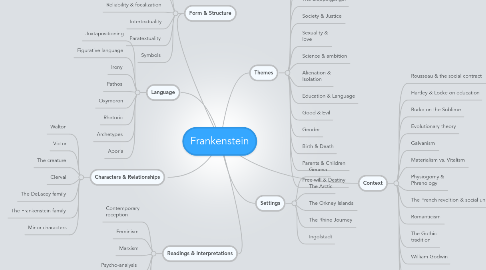Frankenstein
저자: andy fisher

1. Form & Structure
1.1. Epistolic techniques
1.2. Framed narrative
1.3. Reliability & focalization
1.4. Intertextuality
1.5. Paratextuality
1.6. Symbols
2. Readings & Interpretations
2.1. Contemporary reception
2.2. Feminism
2.3. Marxism
2.4. Psycho-analysis
2.5. Structuralism
2.6. Modern & Postmodern
3. Language
3.1. Juxtapositioning
3.2. Figurative language
3.3. Irony
3.4. Pathos
3.5. Oxymoron
3.6. Rhetoric
3.7. Archetypes
3.8. Aporia
4. Characters & Relationships
4.1. Walton
4.2. Victor
4.3. The creature
4.4. Clerval
4.5. The DeLacey family
4.6. The Frankenstein family
4.7. Minor characters
5. Themes
5.1. The Monstrous
5.2. Man and Nature
5.3. The Doppelganger
5.4. Society & Justice
5.5. Sexuality & love
5.6. Science & ambition
5.7. Alienation & Isolation
5.8. Education & Language
5.9. Good & Evil
5.10. Gender
5.11. Birth & Death
5.12. Parents & Children
5.13. Free will & Destiny
6. Context
6.1. Rousseau & the social contract
6.2. Hartley & Locke on education
6.3. Burke on the Sublime
6.4. Evolutionary theory
6.5. Galvanism
6.6. Materialism vs. Vitalism
6.7. Physiogomy & Phrenology
6.8. The French revoltion & social unrest
6.9. Romanticism
6.10. The Gothic tradition
6.11. William Godwin
6.12. Mary Wollstonecraft
6.13. Mary Shelley's biography
7. Settings
7.1. Geneva
7.2. The Arctic
7.3. The Orkney Islands
7.4. The Rhine Journey
7.5. Ingolstadt


